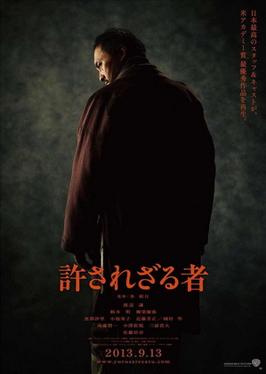Yurusarezaru Mono
5 September 2014 03:58 pm The 1954 epic Japanese samurai film “The Seven Samurai” was remade into the American western film “The Magnificent Seven” in 1960, beginning a long and mostly high quality series of cross-genre appreciations. The latest of these is “Yurusarezaru Mono,” director Sang-il Lee's 2013 reinterpretation of Clint Eastwood's 1992 Academy Award winning “Unforgiven.”
The 1954 epic Japanese samurai film “The Seven Samurai” was remade into the American western film “The Magnificent Seven” in 1960, beginning a long and mostly high quality series of cross-genre appreciations. The latest of these is “Yurusarezaru Mono,” director Sang-il Lee's 2013 reinterpretation of Clint Eastwood's 1992 Academy Award winning “Unforgiven.”In 1868, the Japanese emperor was restored to the throne, deposing the Shogun Yoshinobu Tokugawa whose family had ruled Japan as hereditary dictators for some 250 years. Shogunate samurai, defeated on the battlefield and stripped of their lands and traditional power, fled to the northern island of Hokkaido hoping to form an American-style republic of their own. The rebellion was eventually to be harshly put down. (See the first part of the 2003 film “The Last Samurai”). “Yurusarezaru Mono,” begins in the winter snows of Hokkaido 1869 with Jubei Kamata (Ken Watanabe, “Letters from Iwo Jima”, “Godzilla”) being hunted down by Imperial bounty hunters.
If you've seen Clint Eastwood's original, you know the rest. The story advances to 11 years later where Jubei is a widower and failed farmer. Is old friend Kingu Baba (Akira Emoto, “The Blind Swordsman: Zatoichi”) finds him and asks him to join him in a bounty killing job to avenge a cut-up prostitute. They pick up a Schofield kid, Goro Sawada (Yûya Yagira), along the way. The bounties are killed. King Baba is captured and killed by town sheriff Ichizo Oichi (Kôichi Satô, “Samurai Western Django”). Jubei returns and takes revenge. Roll credits.
It would be easy to dismiss this film as a scene-for-scene remake or, at best, an homage to a classic. But just as “Yojombo” and “A Fist Full of Dollars” are the same story, the one a retelling of the other, they are very different films when taken in context. In the opening scene, the hunter's Western clothes and Springfield rifles establish this move as much in the American Western genre as in the Japanese jidaigeki period drama. The broad, open expanses of the filming locations in Hokkaido again make this seem a much more Western film.
Jubei's survival against the bounty hunter's overwhelming numbers establishes him as a killer, even more so than is done in Eastwood's original, which waits until Ned shows up and then tells us about it rather than showing us.
Most of the reviews I've read say otherwise but I found Watanabe's performance somewhat more emotional. Subtle emotions play over his expressions, almost frame to frame whereas Eastwood tends to glower constantly and consistently, his emotions described by dialogue. This show rather than tell style of filmmaking does tend to leave us wondering at times. The motivations of the sheriff Ichizo are not as clearly defined as they could be and he tends to come across as more psychopathic than he probably should.
The addition of the Ainu subplot and its parallels with the plight of Native Americans reinforces the impression of this being an American Western. For those not familiar, the Ainu people are indigenous to Hokkaido. Under the Shogonate, they were treated as backward neighbors to be dominated, stolen from and occasionally enslaved. Even so, there were occasional treaties, trade agreements and relative peace. With the Meiji Restoration, their lands were claimed by the Imperial Government and their culture was outlawed. What little good “Jubei the Killer” does in the course of the film is attributable to the influence of the plight of the Ainu on the story.
Both the samurai film and the western employ traditional combat tropes. The swiftly drawn sword and flowing slices, the fast draw pistol and shooting from the hip. Eastwood's film tried to dispense with this somewhat but the final fight in “Yurusarezaru Mono” is even more brutal and inelegant. Jubei, with his rusted sword, is no warrior, certainly no samurai. Plain and simple, he is a killer. A killer unforgiven. There is no redemption. There is no returning home. The Japanese Nō theater has a traditional character called the shite who will appear in the narrative first as a human and then as a ghost. In this, Jubei begins as a ghost and only briefly becomes human again before fading away. He ends the film as he began, alone in the snow. Haunted and hunted. I can't really say that I think that this is a better film than the original but I believe this transformational circle makes “Yurusarezaru Mono” a more moving and tragic film.
It is disappointing that it has not received wider distribution in the US. I think western film aficionados would find much to appreciate in this reimagining of a classic.
